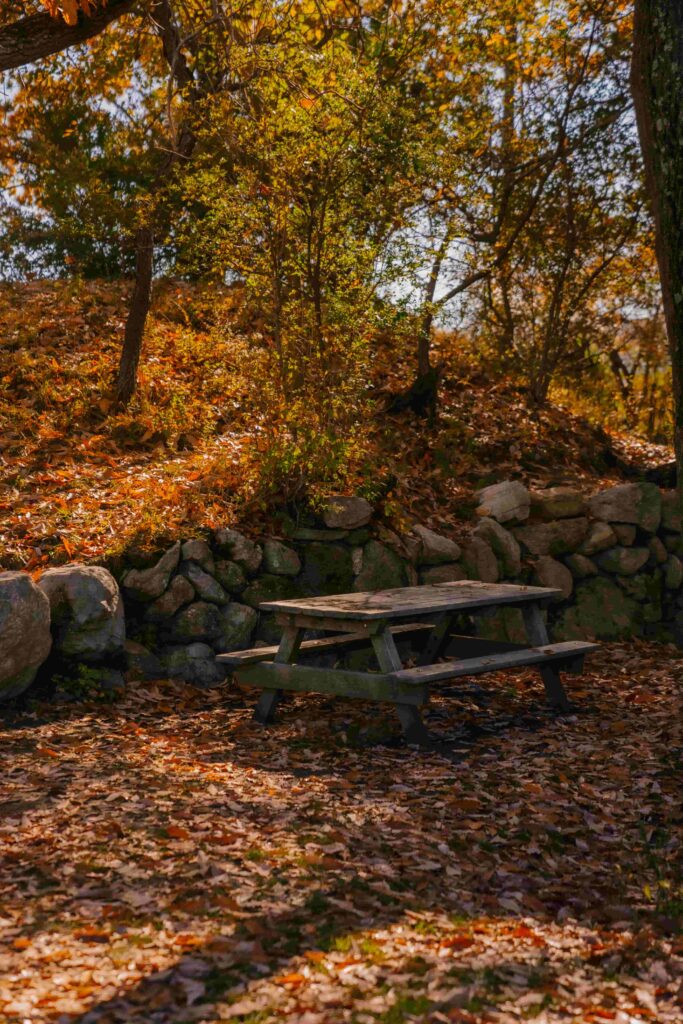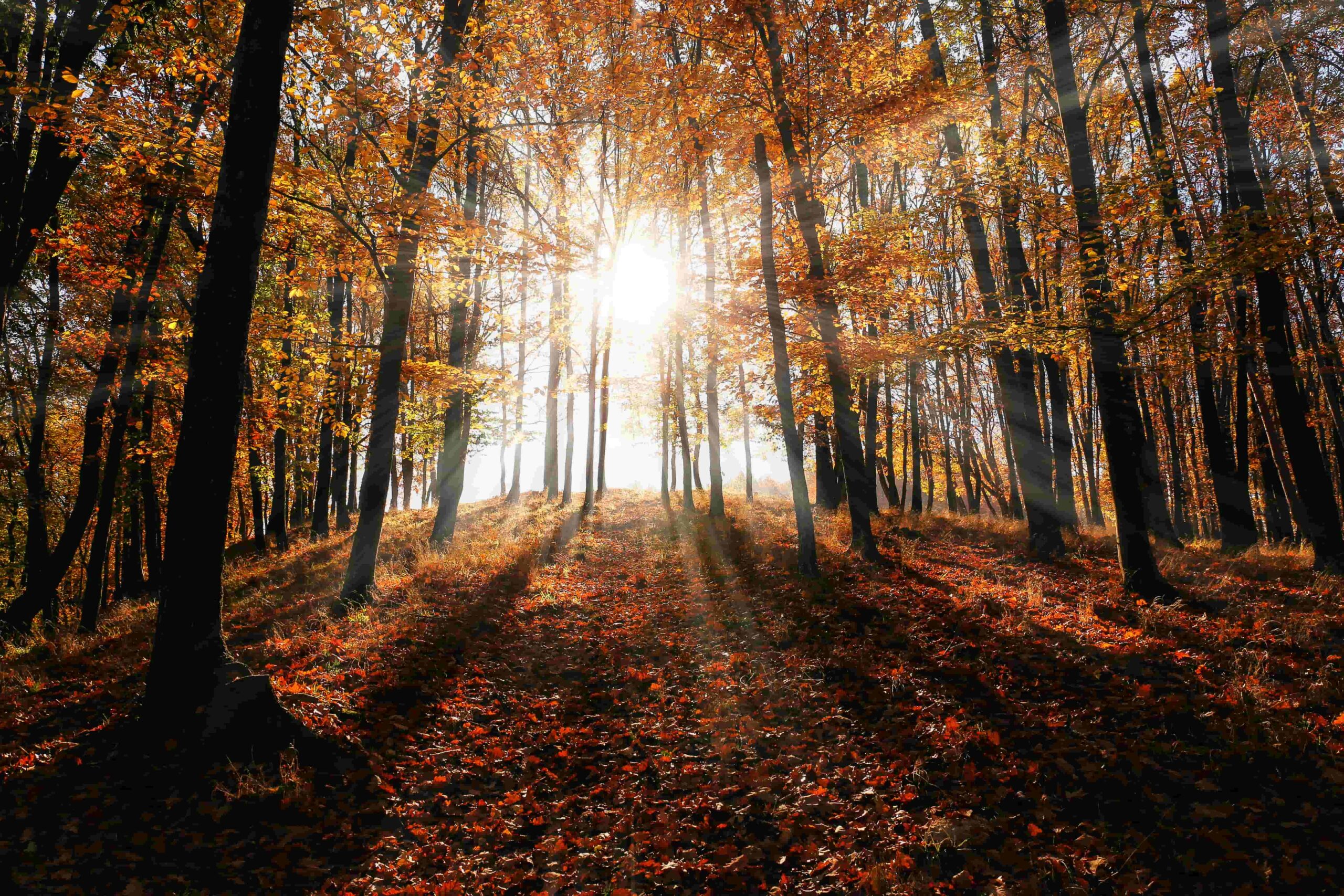परिचय
प्रकृति अपने विविध परिदृश्यों से हमें विस्मित करना कभी बंद नहीं करती, और इनमें से सबसे मनमोहक है पर्णपाती वन। दुनिया के अलग-अलग हिस्सों में फैले पर्णपाती वन, खास तौर पर मौसम के बदलते मौसम के दौरान, एक अनोखा नजारा पेश करते हैं। इस लेख में, हम इन जंगलों की मनमोहक सुंदरता का पता लगाएंगे और जानेंगे कि वे हमारे ग्रह के लिए इतने महत्वपूर्ण क्यों हैं।
पर्णपाती वन क्या हैं?
पर्णपाती वन एक अनोखा बायोम है जहाँ पेड़ पतझड़ के मौसम में अपने पत्ते खो देते हैं, जो उनके विशिष्ट चरित्र को दर्शाता है। ये वन मध्यम वर्षा और अलग-अलग मौसम वाले क्षेत्रों में पाए जा सकते हैं, जैसे कि उत्तरी अमेरिका, यूरोप और एशिया के कुछ हिस्से।
ऋतुओं का चक्र
पर्णपाती वनों में मौसमों का चक्र एक उल्लेखनीय प्राकृतिक घटना है, जिसकी विशेषता चार अलग-अलग मौसम हैं - वसंत, ग्रीष्म, शरद ऋतु (पतझड़), और सर्दी। प्रत्येक मौसम वन पारिस्थितिकी तंत्र में अपने स्वयं के अनूठे परिवर्तन और चुनौतियाँ लाता है:
- वसंत:
- नवोदित और प्रस्फुटित होना: जैसे-जैसे सर्दी कम होती है और तापमान बढ़ता है, पर्णपाती पेड़ों पर नए पत्ते और फूल उगने लगते हैं। इस अवधि में जंगल के फर्श पर विभिन्न जंगली फूल खिलते हैं।
- पशु गतिविधि: पक्षियों और कीड़ों सहित कई जानवर वसंत ऋतु में अधिक सक्रिय हो जाते हैं क्योंकि वे भोजन की तलाश करते हैं, घोंसले बनाते हैं और प्रजनन करते हैं।
- वर्षा: वसंत ऋतु में अक्सर वर्षा बढ़ जाती है, जो वनों को पोषण देती है और पौधों की वृद्धि के लिए आवश्यक नमी प्रदान करती है।
- गर्मी:
- पूर्ण छत्र: गर्मियों तक, पर्णपाती वनों के पेड़ों पर पूरी तरह पत्ते निकल आते हैं, जिससे एक घना छत्र बन जाता है जो विभिन्न प्रजातियों को छाया और आच्छादन प्रदान करता है।
- फलन एवं बीज उत्पादन: इस मौसम में कई पेड़ फल और बीज पैदा करते हैं, जो विभिन्न प्रकार के वन्य जीवन के लिए भोजन का काम करते हैं।
- कीट जीवन: तितलियाँ और मधुमक्खियाँ जैसे कीट गर्मियों के दौरान प्रचुर मात्रा में होते हैं, जो फूलों का परागण करते हैं और पौधों के प्रजनन चक्र में मदद करते हैं।
- शरद ऋतु (पतझड़):
- पर्ण परिवर्तन: पर्णपाती वनों की सबसे खास विशेषताओं में से एक है पत्तियों का रंग बदलना। जैसे-जैसे दिन छोटे होते जाते हैं और तापमान गिरता जाता है, पेड़ अपने पत्तों से क्लोरोफिल को पुनः अवशोषित करके सर्दियों की तैयारी करते हैं, जिससे चमकीले लाल, नारंगी और पीले रंग के रंग निकलते हैं।
- पत्तों का कचरा: गिरती हुई पत्तियां वन भूमि पर पत्तियों का कालीन बना देती हैं, जो अंततः विघटित होकर मिट्टी को समृद्ध बनाती हैं।
- प्रवास और शीतनिद्रा: कई पक्षी और जानवर, जैसे प्रवासी पक्षी और शीतनिद्रा में रहने वाले स्तनधारी, पतझड़ के दौरान आने वाली सर्दियों की तैयारी करते हैं।
- सर्दी:
- पत्ती रहित पेड़: सर्दियों में, पर्णपाती वृक्ष अपने सभी पत्ते गिरा देते हैं, जिससे जंगल की सतह तक अधिक मात्रा में सूर्य का प्रकाश पहुंच पाता है।
- शीतनिद्रा और प्रसुप्ति: कई जानवर ऊर्जा बचाने और ठंड के मौसम में जीवित रहने के लिए हाइबरनेशन या निष्क्रियता की स्थिति में चले जाते हैं। हिरण जैसे कुछ जीव घने फर विकसित करके सर्दियों के अनुकूल हो जाते हैं।
- बर्फ की चादर: ठंडी सर्दियों वाले क्षेत्रों में, बर्फ जंगलों को ढक लेती है, जिससे मिट्टी को इन्सुलेशन और जल भंडार मिलता है।
फिर चक्र दोहराया जाता है, जिसमें प्रत्येक मौसम पर्णपाती वन पारिस्थितिकी तंत्र के समग्र स्वास्थ्य और संतुलन में महत्वपूर्ण भूमिका निभाता है। वसंत और ग्रीष्म ऋतु वृद्धि और प्रजनन के समय को चिह्नित करते हैं, जबकि शरद ऋतु सर्दियों की चुनौतियों के लिए तैयारी करने के लिए समर्पित मौसम है। बदले में, सर्दी आराम और संरक्षण का समय है, चक्र अगले वसंत में नए सिरे से शुरू होता है क्योंकि जंगल विकास और परिवर्तन के एक और वर्ष के लिए जागता है।
पर्णपाती वनों में जैव विविधता
पर्णपाती वन जैव विविधता से भरपूर हैं। इन क्षेत्रों में पौधों और जानवरों की विभिन्न प्रजातियाँ पाई जाती हैं, जो जीवन से भरपूर एक समृद्ध पारिस्थितिकी तंत्र का निर्माण करती हैं।
विशिष्ट वनस्पति और जीव
पर्णपाती वन अपनी अनूठी वनस्पतियों और जीवों के लिए जाने जाते हैं, जिनकी विशेषता पेड़ों द्वारा मौसमी रूप से पत्तियों का गिरना है। ये वन दुनिया के विभिन्न भागों में पाए जाते हैं, और प्रत्येक क्षेत्र की अपनी विशिष्ट प्रजातियाँ होती हैं। पर्णपाती वनों की वनस्पतियों में ओक, मेपल और बीच जैसे चौड़े पत्तों वाले पेड़ों का मिश्रण शामिल है। इस बीच, जीवों में हिरण, गिलहरी और पक्षियों की कई प्रजातियाँ शामिल हैं, जो इन जंगलों के आकर्षण को बढ़ाती हैं।
पर्णपाती वनों में पाए जाने वाले विशिष्ट वनस्पतियों और जीवों के कुछ उदाहरण यहां दिए गए हैं:
वनस्पति (पौधे और पेड़):
- शाहबलूत वृक्ष: शाहबलूत कई पर्णपाती जंगलों में आम हैं, और वे कई तरह के वन्यजीवों का पोषण करते हैं। बलूत के फल, उनके मेवे, कई जानवरों के लिए एक महत्वपूर्ण भोजन स्रोत हैं।
- मेपल के पेड़: मेपल के पेड़ अपने शानदार शरद ऋतु के पत्तों के लिए प्रसिद्ध हैं, जो जंगल में जीवंत रंग भर देते हैं। मेपल सिरप चीनी मेपल के पेड़ों को काटकर प्राप्त किया जाता है।
- बीच के पेड़: बीच के पेड़ अपनी चिकनी, चांदी-ग्रे छाल के लिए जाने जाते हैं और छोटे, त्रिकोणीय मेवे पैदा करते हैं जिन्हें विभिन्न जानवर खाते हैं।
- Dogwood: ये छोटे, फूलदार पेड़ अपने आकर्षक फूलों से भूमिगत क्षेत्र की सुंदरता में चार चांद लगा देते हैं।
- फर्न्स: फर्न की कई प्रजातियां वन भूमि पर पनपती हैं, तथा भूमिगत कालीन का निर्माण करती हैं।
- जंगली फूलपर्णपाती वन प्रायः विभिन्न प्रकार के जंगली फूलों से भरे होते हैं, जिनमें ट्रिलियम, वायलेट और मेयप्पल शामिल हैं।
जीव-जंतु (पशु):
- सफेद दुम वाला हिरन: ये सुंदर शाकाहारी जानवर पर्णपाती जंगलों में आम दृश्य हैं और अपनी चरने की आदतों से पारिस्थितिकी तंत्र को आकार देने में महत्वपूर्ण भूमिका निभाते हैं।
- पूर्वी ग्रे गिलहरी: गिलहरियाँ जंगल में बीज फैलाने में माहिर होती हैं, वे अक्सर मेवों को जमीन में गाड़कर भूल जाती हैं, जिससे वृक्षों का पुनः विकास होता है।
- पूर्वी चिपमंकचिपमंक्स छोटे, धारीदार कृंतक होते हैं जिन्हें अक्सर जंगल में भोजन इकट्ठा करते हुए देखा जाता है।
- रैकूनरैकून अत्यधिक अनुकूलनीय और अवसरवादी सर्वाहारी होते हैं, जो अपनी चतुराईपूर्ण भोजन खोजने की कुशलता के लिए जाने जाते हैं।
- काले भालूकुछ पर्णपाती जंगलों में काले भालू पाए जा सकते हैं। वे सर्वाहारी होते हैं और कई तरह के खाद्य पदार्थ खाते हैं, जिनमें जामुन, मेवे और छोटे स्तनधारी शामिल हैं।
- जंगली टर्की: ये बड़े पक्षी अपने आकर्षक पंखों के लिए जाने जाते हैं और अक्सर जंगल में भोजन की तलाश करते देखे जाते हैं।
- बनबिलावकुछ क्षेत्रों में, मायावी बनबिलाव पर्णपाती जंगलों में घूमता है, तथा खरगोशों और गिलहरियों जैसे छोटे जानवरों का शिकार करता है।
- पूर्वी बॉक्स कछुआ: ये स्थलीय कछुए वन वातावरण के अनुकूल होते हैं और अक्सर जंगल की सतह पर पाए जाते हैं।
- गाने वाले पंछीविभिन्न गीत पक्षी, जैसे कि वारब्लर, थ्रश और कठफोड़वा, पर्णपाती जंगलों में प्रचुर मात्रा में पाए जाते हैं और मधुर ध्वनि परिदृश्य में योगदान देते हैं।
- सैलामैंडरसैलामैंडर की अनेक प्रजातियां, जिनमें लाल पीठ वाला सैलामैंडर और धब्बेदार सैलामैंडर शामिल हैं, नम पत्तियों और गिरे हुए लट्ठों में पनपती हैं।
ये पर्णपाती वनों में पाए जाने वाले विविध और अनोखे वनस्पतियों और जीवों के कुछ उदाहरण मात्र हैं। बदलते मौसम और हर साल पत्तियों का गिरना एक गतिशील वातावरण बनाता है जो कई तरह की प्रजातियों और पारिस्थितिकीय अंतःक्रियाओं का समर्थन करता है।
The Importance of Deciduous Forests

Deciduous forests are ecologically significant and provide a wide range of benefits, making them vital for both the environment and human society. They help to filter the air, provide habitats for numerous creatures, and serve as a source of timber and various forest products. Here are some key reasons why deciduous forests are important:
- Biodiversity: Deciduous forests are home to a rich diversity of plant and animal species. They provide habitat for numerous mammals, birds, insects, and fungi, many of which are adapted to the changing seasons and leaf fall. This biodiversity contributes to the overall health of the planet.
- Carbon Sequestration: Deciduous trees play a crucial role in reducing greenhouse gas levels by absorbing carbon dioxide from the atmosphere through photosynthesis, contributing to the mitigation of climate change.
- Clean Water: Deciduous forests act as natural filters, helping to purify water as it percolates through the soil. They reduce erosion, prevent sedimentation in water bodies, and maintain the quality of freshwater resources.
- Soil Health: The leaf litter from deciduous trees, when it falls and decomposes, enriches the forest soil with organic matter and nutrients. This enhances soil fertility and supports a healthy forest ecosystem.
- Recreation and Aesthetics: Deciduous forests provide recreational opportunities for people, including hiking, birdwatching, and simply enjoying the beauty of the changing seasons. They offer respite from the stresses of urban life and serve as places for cultural and aesthetic appreciation.
- Timber and Non-Timber Forest Products: Deciduous forests are sources of valuable timber, including hardwoods like oak and maple. Additionally, they provide non-timber forest products such as nuts, fruits, and medicinal plants, which have economic and cultural significance.
- Wildlife Habitat: These forests offer essential habitat for numerous wildlife species, supporting their life cycles, from breeding and nesting to overwintering.
- Erosion Control: The dense canopy and leaf litter of deciduous forests help reduce soil erosion, which is particularly important in hilly and mountainous regions.
- Pollination: Many tree and plant species in deciduous forests rely on pollinators, such as bees and butterflies, for reproduction. Healthy forests contribute to pollinator diversity, benefiting agriculture and natural ecosystems.
- Educational and Scientific Value: Deciduous forests are living laboratories for scientific research and education. They offer insights into ecology, climate, and biodiversity, which help us better understand our natural world.
- Cultural and Traditional Significance: Many indigenous groups around the world attach cultural and spiritual value to deciduous forests. Their customs and beliefs frequently center around these woodlands.
- Adaptive Resilience: Deciduous trees adapt to the changing seasons by shedding their leaves, demonstrating the resilience of nature. Understanding how they cope with these cycles can inform strategies for climate adaptation and resilience.
Threats to Deciduous Forests
Sadly, these beautiful forests are under threat from deforestation, habitat loss, and climate change. The need to protect and preserve them is more significant than ever.
संरक्षण के प्रयास
Conservation efforts for deciduous forests are crucial to protect these diverse and ecologically important ecosystems. Here are some common strategies and initiatives aimed at the conservation of deciduous forests:
- Protected Areas and National Parks:
- Establishing and maintaining protected areas and national parks is a fundamental step in conserving deciduous forests. These areas provide a safe haven for diverse flora and fauna, allowing them to thrive undisturbed.
- Reforestation and Afforestation:
- Planting native deciduous tree species and restoring degraded forest areas through reforestation and afforestation efforts can help increase the forested area and biodiversity.
- पर्यावास की बहाली:
- Efforts to restore degraded habitats within deciduous forests are vital. This can include removing invasive species, reestablishing native plant communities, and creating suitable conditions for wildlife.
- Conservation of Key Species:
- Protecting and conserving endangered or keystone species within deciduous forests, such as the European bison in Białowieża Forest, can have cascading positive effects on the entire ecosystem.
- Forest Management Practices:
- Implementing sustainable forest management practices that balance human needs with conservation goals is crucial. These practices include selective logging, prescribed burns, and the protection of old-growth forests.
- Wildlife Corridors:
- Establishing wildlife corridors or greenways connecting fragmented forest areas allows animals to migrate, find food, and maintain genetic diversity.
- Education and Outreach:
- Raising awareness about the value of deciduous forests and their importance for biodiversity, carbon sequestration, and clean water sources can lead to greater public support for conservation efforts.
- Research and Monitoring:
- Ongoing research and monitoring programs help scientists and conservationists better understand the health and dynamics of deciduous forests. This information informs conservation strategies and adaptive management.
- Collaboration and Partnerships:
- Collaboration between governments, non-governmental organizations (NGOs), local communities, and private landowners can be a powerful force in conserving deciduous forests. Partnerships can lead to shared responsibilities and resources.
- जलवायु परिवर्तन शमन:
- Addressing climate change is critical for deciduous forest conservation. Efforts to reduce greenhouse gas emissions and adapt to changing climate conditions are important components of conservation.
- Promotion of Sustainable Tourism:
- Encouraging responsible tourism and sustainable practices in and around deciduous forests can help fund conservation efforts and raise awareness about the importance of these ecosystems.
Conserving deciduous forests is a multifaceted endeavor that requires a combination of scientific knowledge, policy support, community engagement, and international cooperation. By implementing these strategies, we can help ensure that these unique ecosystems continue to provide habitat for diverse species and offer vital ecological services to our planet.
Famous Deciduous Forests Around the World
Deciduous forests can be found in various parts of the world and are famous for their biodiversity and seasonal beauty. Here are some well-known deciduous forests from around the world:
- Black Forest, Germany: The Black Forest, or Schwarzwald in German, is renowned for its dense woodlands, rolling hills, and picturesque villages. Hikers and nature lovers love it since it is home to a wide range of wildlife.
- Great Smoky Mountains, United States: Located on the border of North Carolina and Tennessee, this National Park is a UNESCO World Heritage site and one of the most visited national parks in the United States. It features rich deciduous forests, diverse flora, and abundant wildlife.
- Sherwood Forest, England: Famous for its association with the legendary outlaw Robin Hood, Sherwood Forest is a historic woodland in Nottinghamshire. It’s known for its ancient oak trees and unique ecosystem.
- Jiuzhaigou Valley, China: This UNESCO World Heritage site in Sichuan province is home to a stunning array of colorful lakes, waterfalls, and lush deciduous forests. It’s celebrated for its biodiversity, including the giant panda.
- Białowieża Forest, Poland and Belarus: Białowieża Forest is one of the last and largest parts of the primeval forest that once covered much of Europe. It’s famous for its old-growth trees and as the habitat of the European bison, Europe’s heaviest land animal.
- Great Otway National Park, Australia: Located in Victoria, this national park features temperate rainforests and cool temperate rainforests with a mix of evergreen and deciduous trees. It’s home to diverse flora and fauna, including the elusive platypus.
- New England, United States: The New England region, including states like Vermont, New Hampshire, and Maine, is known for its vibrant fall foliage as the deciduous trees change color. It’s a popular destination for “leaf peeping” in the autumn.
- Croatian Forests, Croatia: Croatia’s forests, such as Plitvice Lakes National Park, offer breathtaking scenery with cascading waterfalls, crystal-clear lakes, and diverse deciduous and evergreen tree species.
- Margalla Hills National Park, Pakistan: Located near Islamabad, this park features a mix of deciduous and evergreen trees and offers opportunities for hiking and bird-watching in a beautiful natural setting.
- Dandenong Ranges, Australia: These lush, temperate rainforests near Melbourne are home to towering mountain ash trees, tree ferns, and a range of bird species. The area is a popular spot for tourists and nature lovers.
These famous deciduous forests showcase the beauty and ecological importance of such ecosystems around the world. They attract visitors and researchers alike, contributing to our understanding of these unique environments.
निष्कर्ष
Deciduous forests are a treasure trove of natural beauty and are of immense ecological, economic, and cultural importance. They contribute to our overall well-being by supporting biodiversity, mitigating climate change, and providing a host of ecosystem services. Conservation and sustainable management of these forests are essential to ensure their continued benefits for current and future generations. It’s our responsibility to ensure that future generations can continue to unveil the wonder of these enchanting landscapes.
पूछे जाने वाले प्रश्न
1. Are deciduous forests only found in North America?
No, There are deciduous forests all across the world, especially in portions of Asia and Europe. Each region offers its unique charm and biodiversity.
2. Why do deciduous trees shed their leaves in the autumn?
Deciduous trees shed their leaves as a survival strategy for conserving water and energy during the colder months.
3. Can deciduous forests be visited year-round?
Yes, deciduous forests offer different experiences throughout the year, from the vibrant colors of autumn to the tranquility of winter.
4. How can I contribute to the conservation of deciduous forests?
Supporting organizations dedicated to forest conservation and making sustainable choices in your daily life can help protect these valuable ecosystems.
5. Are there guided tours available for exploring deciduous forests?
Yes, in many regions, you can find guided tours and nature programs that allow you to explore deciduous forests safely and learn more about their unique features.

